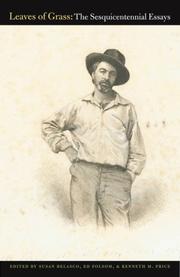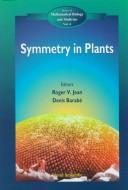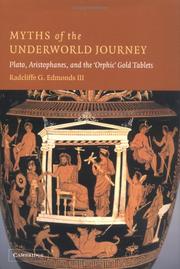| Listing 1 - 10 of 42 | << page >> |
Sort by
|
Book
ISBN: 0191651192 Year: 2014 Publisher: OUP Oxford
Abstract | Keywords | Export | Availability | Bookmark
 Loading...
Loading...Choose an application
- Reference Manager
- EndNote
- RefWorks (Direct export to RefWorks)
Leaves are among the most abundant organs on earth and are a defining feature of most terrestrial ecosystems. However, a leaf is also a potential meal for a hungry animal and the question therefore arises, why does so much foliage survive in nature? What mechanisms protect leaves so that, on a global scale, only a relatively small proportion of living leaf material is consumed? Leaf survival is in large part due to two processes: firstly, leaf-eating organisms fall prey to predators (top-down pressure on the herbivore); secondly, leaves defend themselves (bottom-up pressure on the herbivore). Remarkably, these two types of event are often linked; they are controlled and coordinated by plants and the molecular mechanisms that underlie this are now beginning to emerge.This novel text focuses exclusively on the leaf, on the herbivorous organisms that attack leaves, and the mechanisms that plants use to defend these vital organs. It begins with an assessment of the scale of herbivory, before examining direct physical and chemical defences on leaf surfaces and within the leaf itself. Although some leaf defences are easily seen, most operate at the molecular level and are therefore invisible to the naked eye. Many of these recently elucidated mechanisms are described. Throughout the book, perspectives from both the laboratory and the field are combined. A central feature of the work is its emphasis on the coevolution of leaf defences and the digestive tracts of animals including humans, making the book of relevance in understanding the role of leaf defences in agriculture.Leaf Defence is suitable for senior undergraduate and graduate students taking courses in plant science, as well as a broader audience of biologists and biochemists seeking a comprehensive and authoritative overview of this exciting and emerging topic.
Leaves --- Plant Ecology --- Nature --- Science --- Plant ecology
Book
Year: 2022 Publisher: University of Ottawa Press
Abstract | Keywords | Export | Availability | Bookmark
 Loading...
Loading...Choose an application
- Reference Manager
- EndNote
- RefWorks (Direct export to RefWorks)
"The Academic Sabbatical: A Voyage of Discovery is a collection of narratives that reveals how important sabbaticals are to faculty and, by extension, to higher education. By taking an in-depth look at the diverse experiences and perspectives shared by its collaborators, this work provides significant evidence that academic sabbaticals are instrumental in increasing productivity in terms of research and knowledge dissemination, the essence of today’s university studies. Thanks to these earned periods of self-directed focused work, scholars can restore their academic energies, which leads to enhanced program development, renewed dedication to graduate students, and intellectual sharing among peers. Although not without challenges and tensions, sabbaticals help academics build stronger and deeper connections, laying a solid foundation for future growth and achievement. While this book stands alone in promoting the richness and power of the sabbatical as a structural feature of the academy, it is a great follow-up to The Academic Gateway and Beyond the Academic Gateway, the two titles that preceded this current book, and which discuss the tenure-track and tenure decision in academia."--
Sabbatical leave. --- College teachers --- Leaves of absence. --- Teacher training
Book
Year: 2015 Publisher: Lanham, Maryland : Lexington Books,
Abstract | Keywords | Export | Availability | Bookmark
 Loading...
Loading...Choose an application
- Reference Manager
- EndNote
- RefWorks (Direct export to RefWorks)
This volume discusses why faculty and administrators of academe should care about implementing family-friendly policies and practices, as well as how faculty and administrators can advocate for policy changes. Faculty and administrators can benefit from these case studies' guidance on how to create family-friendly campuses at their institutions.
College personnel management --- College teachers --- College teachers --- College personnel management --- College teachers --- College teachers --- Family relationships --- Leaves of absence. --- Family relationships --- Leaves of absence

ISBN: 1281092363 9786611092368 0803208782 9780803208780 6611092366 9781281092366 9780803260009 0803260008 Year: 2007 Publisher: Lincoln University of Nebraska Press
Abstract | Keywords | Export | Availability | Bookmark
 Loading...
Loading...Choose an application
- Reference Manager
- EndNote
- RefWorks (Direct export to RefWorks)
Contains seventeen essays by pre-eminent scholars representing a variety of critical perspectives that focus on Walt Whitman's ""Leaves of Grass"". This book features contributors who treat Whitman's poetry, his biography, his politics, his reception in the United States and abroad, race and ethnic issues, and nineteenth-century America.
Whitman, Walt, 1819-1892. Leaves of grass. --- English --- Languages & Literatures --- American Literature --- Whitman, Walt,

ISBN: 9814261076 9789814261074 9810226217 9789810226213 Year: 1998 Publisher: Singapore River Edge, NJ World Scientific
Abstract | Keywords | Export | Availability | Bookmark
 Loading...
Loading...Choose an application
- Reference Manager
- EndNote
- RefWorks (Direct export to RefWorks)
The book deals with biological, mathematical, descriptive, causal and systemic phyllotaxis. It aims at reflecting the widest possible range of ideas and research closely related to phyllotaxis and contains 30 well illustrated chapters.The book has three parts of equal importance. The first two parts concern data collecting, pattern recognition and pattern generation to which students of phyllotaxis are well accustomed. The third part is devoted to the problem of origins of phyllotactic patterns, giving the field of phyllotaxis the universality it requires to be fully understood.Phyllotaxis-lik
Phyllotaxis --- Plant morphogenesis --- Symmetry (Biology) --- Investigative Techniques --- Biology --- Phenomena and Processes --- Biological Science Disciplines --- Analytical, Diagnostic and Therapeutic Techniques and Equipment --- Natural Science Disciplines --- Disciplines and Occupations --- Plant Physiological Phenomena --- Botany --- Models, Theoretical --- Earth & Environmental Sciences --- Plant Anatomy --- Mathematical models --- Mathematical models. --- Phyllotaxy --- Plant embryology --- Plant morphology --- Morphogenesis --- Leaves
Book
ISBN: 1441617582 9781441617583 9781620360279 1620360276 9781579223304 9781579223311 100344461X 1000971686 1000976963 1579223311 Year: 2009 Publisher: Sterling, Va. Stylus
Abstract | Keywords | Export | Availability | Bookmark
 Loading...
Loading...Choose an application
- Reference Manager
- EndNote
- RefWorks (Direct export to RefWorks)
College teachers --- Parental leave --- Doctoral students --- PhD students --- Ph. D. students --- Graduate students --- Family leave --- Infant care leave --- Leave for parenting --- Leave of absence --- Academicians --- Academics (Persons) --- College instructors --- College lecturers --- College professors --- College science teachers --- Lectors (Higher education) --- Lecturers, College --- Lecturers, University --- Professors --- Universities and colleges --- University academics --- University instructors --- University lecturers --- University professors --- University teachers --- Teachers --- Leaves of absence. --- Services for --- Faculty
Book
Year: 2022 Publisher: Basel MDPI - Multidisciplinary Digital Publishing Institute
Abstract | Keywords | Export | Availability | Bookmark
 Loading...
Loading...Choose an application
- Reference Manager
- EndNote
- RefWorks (Direct export to RefWorks)
The focus of this Special Issue was on biomass ash valorization with respect to their potential for various material applications. Most of the publications in this Special Issue focused on the production of biogenic silica with different properties. Additionally, some of the publications considered application of biomass ashes and biochar as a fertilizer, for soil amendment and recovery of ash forming elements such as N and P, as well as the application of biomass feedstocks in biofuel production.Accordingly, ashes produced from the thermochemical conversion of agricultural residues have high potential to be utilized for different material applications. However, local availability, as well as scaling up the process and life-cycle assessment should be considered prior to the utilization of these materials. Furthermore, densification as a mechanical pre-treatment can be crucial to improve the fuel properties, while purification of some of the ash forming elements, such as calcium, potassium, and prosperous should also not be disregarded in future investigations.
rice husk --- rice husk ash --- silica --- engineered particle --- bottom-up process --- silica extraction --- valorization --- agricultural byproduct --- sustainable material --- biomass --- renewable material --- biogenic amorphous silica --- green chemistry --- maize leaves --- sugarcane fiber --- sugarcane leaves --- sugarcane pith --- biorefinery --- multi-objectives RSM --- nano-silica --- de-ashing --- cellulose crystals --- carbon nanotubes --- cellulose --- sugarcane bagasse --- capacitance --- maize straw --- acid leaching --- ash --- pyrolysis --- nitrogen conversion --- wood ash --- fertilizer --- heat and power plants --- heavy metals --- nutrients --- German fertilizer legislation --- alkaline leaching --- continuous process --- bio-based material --- waste --- exhausted grape marc --- biochar --- soil amendment --- biogas --- lifecycle assessment --- greenhouse gas emissions --- mitigation potential --- GHG mitigation costs --- manure --- biomethane --- RED II --- EU ETS --- smoldering --- high moisture content --- specific surface area --- rice straw --- nanosilica --- methylene blue --- zero waste generation --- decolorization --- SDGs --- municipal sewage sludge --- energy recovery --- phosphorus recovery --- techno-economic analysis --- mono-combustion --- co-combustion --- n/a
Book
Year: 2021 Publisher: Basel, Switzerland MDPI - Multidisciplinary Digital Publishing Institute
Abstract | Keywords | Export | Availability | Bookmark
 Loading...
Loading...Choose an application
- Reference Manager
- EndNote
- RefWorks (Direct export to RefWorks)
Metal ions are fundamental elements for the maintenance of the lifespan of plants, animals and humans. Their substantial role in biological systems was recognized a long time ago. They are essential for the maintenance of life and their absence can cause growth disorders, severe malfunction, carcinogenesis or death. They are protagonists as macro- or microelements in several structural and functional roles, participating in many bio-chemical reactions, and arise in several forms. They participate in intra- and intercellular communications, in maintaining electrical charges and osmotic pressure, in photosynthesis and electron transfer processes, in the maintenance of pairing, stacking and the stability of nucleotide bases and also in the regulation of DNA transcription. They contribute to the proper functioning of nerve cells, muscle cells, the brain and the heart, the transport of oxygen and to many other biological processes up to the point that we cannot even imagine a life without metals. In this book, the papers published in the Special Issue “The Role of Metal Ions in Biology, Biochemistry and Medicine” are summarized, providing a picture of metal ion uses in biology, biochemistry and medicine, but also pointing out the toxicity impacts on plants, animals, humans and the environment.
aluminium --- chlorophyll fluorescence --- durum wheat --- excitation pressure --- non-photochemical quenching --- photosynthesis --- photoprotection --- photoinhibition --- reactive oxygen species --- triticale --- Cd toxicity --- detoxification mechanism --- photochemical quenching --- photosynthetic heterogeneity --- photoprotective mechanism --- phytoremediation --- plastoquinone pool --- redox state --- spatiotemporal variation --- mercury --- biosorption --- dead cells --- Lysinibacillus sphaericus --- dithizone --- GF-AAS --- EDS-SEM --- adaptive response --- hormetic response --- hydrogen peroxide --- marine angiosperms --- reactive oxygen species (ROS) --- zinc oxide nanoparticles --- titanium dioxide --- nanoparticles --- solubility --- toxicity --- skin --- safety --- bimetallic nanoparticles --- mature leaves --- spatiotemporal heterogeneity --- young leaves --- osteoblasts --- corrosion --- ions --- particles --- osteolysis --- inflammation --- bioimaging --- clary sage --- effective quantum yield (ΦPSΙΙ) --- non-photochemical quenching (NPQ) --- photochemical quenching (qp) --- singlet oxygen (1O2) --- aseptic loosening --- metal ions --- monocytes --- macrophages --- 5-caffeoylquinic acid --- chlorogenic acid --- zinc --- plant phenolic compounds --- oxidative stress --- n/a
Book
Year: 2022 Publisher: Basel MDPI - Multidisciplinary Digital Publishing Institute
Abstract | Keywords | Export | Availability | Bookmark
 Loading...
Loading...Choose an application
- Reference Manager
- EndNote
- RefWorks (Direct export to RefWorks)
This Special Issue of the International Journal of Molecular Science comprises a comprehensive study on “Antimicrobial Materials with Medical Applications”. The Special Issue has been inspired by the great progress made in the development of new antimicrobial materials that go beyond the resistance of microbes to modern antibiotics. It covers a selection of recent research and review articles in the field of antimicrobial materials and their medical applications. Moreover, it also provides an overview of this increasingly diverse field, presenting recent developments and the latest research, with particular emphasis on new antimicrobial surfaces, medical devices, contact lens, package materials, etc.
bisdemethoxycurcumin --- curcumin --- curcuminoid --- demethoxycurcumin --- photodynamic inactivation --- Staphylococcus aureus --- Staphylococcus epidermis --- prosthetic joint infection --- fracture-related infection --- bone graft substitute --- revision arthroplasty --- local antibiotic --- antimicrobial activity --- oxo-titanium(IV) complexes --- polymer-inorganic composites --- physicochemical properties --- thermal properties --- multi-functionalized cellulose microfibers --- controlled release --- wound dressing --- antioxidant activity --- sericin --- AgNPs --- ZnO --- green synthesis --- cavity disinfection --- antimicrobial substances --- chlorhexidine --- adhesion --- bonding --- dental caries --- Cr2O3 --- Abutilon indicum (L.) Sweet --- antibacterial --- anticancer --- antioxidant --- biocompatibility --- metallic nanoparticles --- silver --- gold --- synthesis --- characterization --- surface reactivity --- stability --- antibacterial activity --- Escherichia coli --- multidrug resistant bacteria --- silver nanoparticles --- oregano leaves’ extract --- antimicrobial materials --- hydrogels --- contact lens --- plasma electrolytic oxidation --- additive manufacturing --- titanium bone implants --- antibacterial biomaterials --- surface biofunctionalization --- implant-associated infection --- cavity disinfectants --- primary teeth --- bond strength --- face shield --- facial protective equipment --- SARS-CoV-2 --- phage phi 6 --- MRSA --- MRSE --- polyethylene terephthalate --- benzalkonium chloride --- COVID-19 --- multidrug-resistant bacteria --- bioreduction --- biocapping agent --- bionanofactories --- biomedical --- n/a --- oregano leaves' extract

ISBN: 0521834341 9780511265594 051126559X 0511263309 9780511263309 0511264119 9780511264115 1280749636 9781280749636 9780521834346 1107161045 9781107161047 0511264879 9780511264870 0511317328 9780511317323 051149789X 1107407303 9781107407305 9780511497896 Year: 2012 Publisher: Cambridge Cambridge University Press
Abstract | Keywords | Export | Availability | Bookmark
 Loading...
Loading...Choose an application
- Reference Manager
- EndNote
- RefWorks (Direct export to RefWorks)
This book was first published in 2004. Plato, Aristophanes and the creators of the 'Orphic' gold tablets employ the traditional tale of a journey to the realm of the dead to redefine, within the mythic narrative, the boundaries of their societies. Rather than being the relics of a faded ritual tradition or the products of Orphic influence, these myths can only reveal their meanings through a close analysis of the specific ways in which each author makes use of the tradition. For these authors, myth is an agonistic discourse, neither a kind of sacred dogma nor a mere literary diversion, but rather a flexible tool that serves the wide variety of uses to which it is put. The traditional tale of the journey to the Underworld in Greek mythology is neither simple nor single, but each telling reveals a perspective on the cosmos, a reflection of the order of this world through the image of the other.
Dionysia --- Mythology, Greek --- Mythology, Greek, in literature --- Voyages to the otherworld --- Voyages to the otherworld in literature --- Subterranean voyages --- Underworld, Voyages to the --- Voyages to the underworld --- Voyages, Imaginary --- Greek mythology --- Orphic mysteries --- Orphism --- Cults --- Aristophanes. --- Plato. --- Mythology, Greek. --- Voyages to the otherworld. --- Dionysia. --- Mythology, Greek, in literature. --- Voyages to the otherworld in literature. --- Lamellae aureae Orphicae. --- Orphicae lamellae --- Lamine d'oro orfiche --- Orphic gold leaves --- Orphic gold tablets --- Arts and Humanities --- History --- Thematology --- Comparative literature --- Aristophanes [Comicus] --- Plato
| Listing 1 - 10 of 42 | << page >> |
Sort by
|

 Search
Search Feedback
Feedback About UniCat
About UniCat  Help
Help News
News